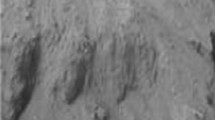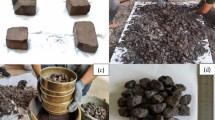Abstract
In this paper, the effects of recycled Refractory Brick Aggregates (RBA) and water/cement ratio (w/c) on the physical and mechanical properties of concrete were experimentally studied. For this purpose, three series of mixes, with different compositions were prepared. In the first series, conventional reference concrete was made with 100% of Natural Aggregates (NA). In the second series, concrete was manufactured by replacing 20% of coarse NA with coarse RBA. In the third series, concrete was produced by replacing 20% of coarse and fine NA with coarse and fine RBA. In all mixes, three w/c ratios (w/c = 0.59, 0.47 and 0.38) were evaluated. The following parameters were examined in this experiment: water absorption, water porosity, density, Ultrasonic Pulse Velocity (UPV), compressive strength and dynamic modulus of elasticity. The experimental results showed that the performance of concrete made with RBA is slightly inferior to that of conventional concrete. On the other hand, the deterioration of UPV and dynamic modulus of elasticity of concrete made with 20% coarse and fine RBA were slightly higher than that of concrete made with 20% of coarse RBA. The same results are observed for the water absorption and water porosity. However, replacing 20% of coarse and fine RBA leads to an improvement in the concrete's compressive strength and density. Meanwhile, based on a comparison with existing data, it is found that lower w/c ratio resulted in lower porosity of concrete, and the decrease of porosity generally led to the improvement of the performance of concrete.



















Similar content being viewed by others
Change history
20 September 2022
A Correction to this paper has been published: https://doi.org/10.1007/s41062-022-00913-w
Abbreviations
- NA:
-
Natural Aggregates
- RBA:
-
Refractory Brick Aggregates
- UPV:
-
Ultrasonic Pulse Velocity
- w/c:
-
Water to Cement ratio
- CRBA:
-
Coarse Refractory Brick Aggregates
- CFRBA:
-
Coarse and Fine Refractory Brick Aggregates
References
Ghazy MF (2020) Optimization of recycled concrete aggregate geopolymer bricks by taguchi method. Revista de la Construccion/J Constr 19(2):244–254. https://doi.org/10.7764/rdlc.19.2.244
Ghazy MF, Abd Elaty AAA, Abo-Elenain MT (2022) Characteristics and optimization of cement concrete mixes with recycled asphalt pavement aggregates. Innov Infrastruct Solut 7(1):1–15. https://doi.org/10.1007/s41062-021-00651-5
Al-Hasan SJA, Balamuralikrishnan R, Altarawneh M (2020) Eco-friendly Asphalt approach for the development of sustainable roads. J Hum Earth Future 1(3):97–111
Khan Z, Gul A, Shah SAA, Samiullah Q, Wahab N, Badshah E, Shahzada K (2021) Utilization of marble wastes in clay bricks: a step towards lightweight energy efficient construction materials. Civ Eng J 7(09):1488–1500. https://doi.org/10.28991/cej-2021-03091738
Zanjad N, Pawar S, Nayak C (2022) Use of fly ash cenosphere in the construction industry: a review. Mater Today Proc. https://doi.org/10.1016/j.matpr.2022.03.362
Hasan ZA, Abdulridha SQ, Abeer SZ (2021) Sustainable mortar made with local clay bricks and glass waste exposed to elevated temperatures. Civ Eng J 7(8):1341–1354
Hachemi S, Ounis A (2015) Performance of concrete containing crushed brick aggregate exposed to different fire temperatures. Eur J Environ Civ Eng 19(7):805–824. https://doi.org/10.1080/19648189.2014.973535
Hachemi S (2015) Study of the behavior of concrete subjected to high temperature: Influence of the type of concrete and the nature of the constituents, Thesis of science Doctorate in Civil Engineering, University of Biskra, Biskra
Huda SB, Shahria Alam M (2015) Mechanical and freeze-thaw durability properties of recycled aggregate concrete made with recycled coarse aggregate. J Mater Civ Eng 27(10):04015003. https://doi.org/10.1061/(ASCE)MT.1943-5533.0001237
Kapoor K, Singh SP, Singh B (2020) Evaluating the durability properties of self-compacting concrete made with coarse and fine recycled concrete aggregates. Eur J Environ Civ Eng 24(14):2383–2399. https://doi.org/10.1080/19648189.2018.1506825
Khattab M, Hachemi S (2021) Performance of recycled aggregate concrete made with waste refractory brick. Int J Eng Res Afr 57:99–113. https://doi.org/10.4028/www.scientific.net/JERA.57.99
Kate GK, Nayak CB, Thakare SB (2021) Optimization of sustainable high-strength–high-volume fly ash concrete with and without steel fiber using Taguchi method and multi-regression analysis. Innov Infrastruct Solut 6(2):1–18. https://doi.org/10.1007/s41062-021-00472-6
Parlikar AS, Naik CV, Nayak CB (2021) An experimental study on effect of pharmaceutical industrial waste water on compressive strength of concrete. Int J Innov Res Sci Eng Technol 10(8):11068–11072
Horckmans L, Nielsen P, Dierckx P, Ducastel A (2019) Recycling of refractory bricks used in basic steelmaking: a review. Resour Conserv Recycl 140:297–304. https://doi.org/10.1016/j.resconrec.2018.09.025
Kavas T, Karasu B, Arslan O (2006) Utilization of refractory brick wastes in concrete production as aggregates. In: Sohn international symposium advanced processing of metals and materials, vol 5, pp 479-83
Saidi M, Safi B, Bouali K, Benmounah A, Samar M (2015) Improved behaviour of mortars at a high temperature by using refractory brick wastes. Int J Microstruct Mater Prop 10(5–6):366–380. https://doi.org/10.1504/IJMMP.2015.074992
Saidi M, Safi B, Benmounah A, Megdoud N, Radi F (2016) Physico-mechanical properties and thermal behavior of firebrick-based mortars in superplasticizer presence. Constr Build Mater 104:311–321. https://doi.org/10.1016/j.conbuildmat.2015.12.026
Aboutaleb D, Safi B, Chahour K, Belaid A (2017) Use of refractory bricks as sand replacement in self-compacting mortar. Cogent Eng 4(1):1360235. https://doi.org/10.1080/23311916.2017.1360235
Nematzadeh M, Baradaran-Nasiri A (2018) Residual properties of concrete containing recycled refractory brick aggregate at elevated temperature. J Mater Civ Eng 30:04017255. https://doi.org/10.1061/(ASCE)MT.1943-5533.0002125
Nematzadeh M, Dashti J, Ganjavi B (2018) Optimizing compressive behavior of concrete containing fine recycled refractory brick aggregate together with calcium aluminate cement and polyvinyl alcohol fibers exposed to acidic environment. Constr Build Mater 4164:837–849. https://doi.org/10.1016/j.conbuildmat.2017.12.230
Zeghad M, Mitterpach J, Safi B, Amrane B, Saidi M (2017) Reuse of refractory brick wastes (RBW) as a supplementary cementitious material in a concrete. Period Polytech Chem Eng 61(1):75–80. https://doi.org/10.3311/PPci.8194
Khattab M, Hachemi S, Al Ajlouni MF (2022) Evaluating the physical and mechanical properties of concrete prepared with recycled refractory brick aggregates after elevated temperatures’ exposure. Constr Build Mater 311:125351. https://doi.org/10.1016/j.conbuildmat.2021.125351
French standardization P 18-554 (1990) Aggregates—measurement of densities, porosity, absorption coefficient and water content of fine gravel and pebbles. French Association for Standardization (AFNOR), Tour Europe cedex 7 92049, Paris
French standardization P 18-555. (1990). Aggregates – Measurement of densities, absorption coefficient and water content of sands. French Association for Standardization (AFNOR). Tour Europe cedex 7 92049. Paris
French standardization P 18-573. (1990). Aggregates—Los Angeles test. French Association for Standardization (AFNOR), Tour Europe cedex 7 92049, Paris
French standardization P 18-598 (1991) Aggregates—Sand equivalent. French Association for Standardization (AFNOR), Tour Europe cedex 7 92049, Paris
French standardization P 18-560 (1990) Aggregates—Particle size distribution by sieving. French Association for Standardization (AFNOR), Tour Europe cedex 7 92049, Paris
Dreux G, Festa J (1998) New guide to concrete and its constituents. Edition Eyrolles, Paris
European Standard NF EN 12390-7 (2001) Test for hardened concrete Part 7: density of concrete. ISSN 0335-3931. The French Association of Standardization (AFNOR), 11 avenue Francis de Pressens´e 93571 Saint-Denis La Plaine Cedex
BS 1881-122:1983 Testing concrete. Method for determination of water absorption, January 31 1983
French standardization P 18-418 (1989). Concrete—sonic auscultation, measurement of the sonic wave transmission time in concrete. French Association for Standardization (AFNOR), Tour Europe cedex 7 92080, Paris
ASTM C 597-16 (2016) Standard test method for pulse velocity through concrete. Book of standards, vol 04.02
Laneyrie C, Beaucour AL, Green MF, Hebert RL, Ledesert B, Noumowe A (2016) Influence of recycled coarse aggregates on normal and high performance concrete subjected to elevated temperatures. Constr Build Mater 111:368–378
European Standard NF EN 12390-3 (2003) Test for hardened concrete Part 3: compressive strength of test specimens. ISSN 0335-3931. The French Association of Standardization (AFNOR), 11 avenue Francis de Pressensé France 93571 Saint-Denis La Plaine Cedex
European Standard NF EN 12390-4 (2000) Test for hardened concrete Part 4: characteristics of test machines. ISSN 0335-3931, The French Association of Standardization (AFNOR), 11 avenue Francis de Pressensé France 93571 Saint-Denis La Plaine Cedex
Kou SC, Poon CS (2015) Effect of the quality of parent concrete on the properties of high performance recycled aggregate concrete. Constr Build Mater 77:501–508. https://doi.org/10.1016/j.conbuildmat.2014.12.035
Piasta W, Zarzycki B (2017) The effect of cement paste volume and w/c ratio on shrinkage strain, water absorption and compressive strength of high performance concrete. Constr Build Mater 140:395–402
Gao Y, De Schutter G, Ye G, Tan Z, Wu K (2014) The ITZ microstructure, thickness and porosity in blended cementitious composite: effects of curing age, water to binder ratio and aggregate content. Compos Part B Eng 60:1–13
Dang J, Zhao J (2019) Influence of waste clay bricks as fine aggregate on the mechanical and microstructural properties of concrete. Constr Build Mater 228:116757. https://doi.org/10.1016/j.conbuildmat.2019.116757
Whitehurst EA (1951) Soniscope tests concrete structures. J Am Concr Inst 47:443–444
Rao MC (2018) Properties of recycled aggregate and recycled aggregate concrete: effect of parent concrete. Asian J Civ Eng 19(1):103–110
González JS, Gayarre FL, Pérez CLC, Ros PS, López MAS (2017) Influence of recycled brick aggregates on properties of structural concrete for manufacturing precast prestressed beams. Constr Build Mater 149:507–514
Alves AV, Vieira TF, De Brito J, Correia JR (2014) Mechanical properties of structural concrete with fine recycled ceramic aggregates. Constr Build Mater 64:103–113. https://doi.org/10.1016/j.conbuildmat.2014.04.037
Gesoglu M, Güneyisi E, ÖzHÖ TI, Yasemin MT (2015) Failure characteristics of self-compacting concretes made with recycled aggregates. Constr Build Mater 98:334–344. https://doi.org/10.1016/j.conbuildmat.2015.08.036
Kwan W, Ramli M, Kam KJ, Sulieman MZ (2012) Influence of the amount of recycled coarse aggregate in concrete design and durability properties. Constr Build Mater 26(1):565–573. https://doi.org/10.1016/j.conbuildmat.2011.06.059
Singh D, Singh SP (2020) Influence of recycled concrete aggregates and blended cements on the mechanical properties of pervious concrete. Innov Infrastruct Solut 5:66. https://doi.org/10.1007/s41062-020-00314-x
Author information
Authors and Affiliations
Corresponding author
Ethics declarations
Conflict of interest
On behalf of all authors, the corresponding author states that there is no conflict of interest.
Additional information
The article was revised due to change in author names.
Rights and permissions
Springer Nature or its licensor holds exclusive rights to this article under a publishing agreement with the author(s) or other rightsholder(s); author self-archiving of the accepted manuscript version of this article is solely governed by the terms of such publishing agreement and applicable law.
About this article
Cite this article
Hachemi, S., Khattab, M. & Benzetta, H. The effects of recycled brick and water/cement ratios on the physical and mechanical performance of recycled aggregates concrete. Innov. Infrastruct. Solut. 7, 270 (2022). https://doi.org/10.1007/s41062-022-00868-y
Received:
Accepted:
Published:
DOI: https://doi.org/10.1007/s41062-022-00868-y




